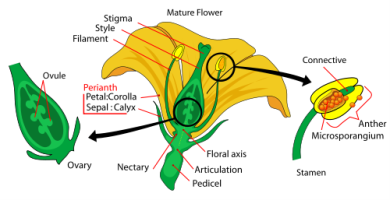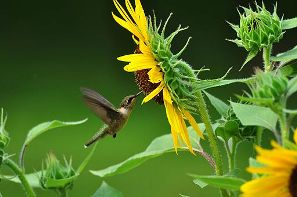Reproduction
As a angiosperm the Aquilegia Vulgaris has flowering
parts with both male and female parts ( hermaphroditic) and in
order to make seeds the female parts have to be pollinated by
male parts. The male parts are called the stamen and the female
parts are called the carpel.
hermaphroditic) and in
order to make seeds the female parts have to be pollinated by
male parts. The male parts are called the stamen and the female
parts are called the carpel.
Columbine utilizes other organisms to help pollinate other
flowers, this process is called biotic pollination. The animals
commonly used for Columbine have long proboscises because the
nectar is all the way in the back of the long spur. Organisms
with the capability to reach the nectar are bees, birds (
usually ©LadyofHats, Wikicommons
humming birds), and butterflies.
Once the organism comes to retrieve the nectar from the spur they inadvertently rub against the stamen, collecting the male
gametes for fertilization. From there the organism continues to
other flowers and transporting the pollen to the carpel of
different plants. Once the pollen lands on the carpel it rests
on the stigma part of the plant ( the tip of the carpel). From
there pollen tubes grow until they pierce the style of the
carpel. From there the pollen grain migrates to the ovule where
the female gametes are located.
they inadvertently rub against the stamen, collecting the male
gametes for fertilization. From there the organism continues to
other flowers and transporting the pollen to the carpel of
different plants. Once the pollen lands on the carpel it rests
on the stigma part of the plant ( the tip of the carpel). From
there pollen tubes grow until they pierce the style of the
carpel. From there the pollen grain migrates to the ovule where
the female gametes are located.
The pollen grain joins together with the ovules and forms a
embryo in a process called double fertilization. From there the
flower proceeds to become a ovary for the seeds that were
produced, also known as fruit. ©Flickr:
Good morning!
Since Aquilegia Vulgaris is a perennial (lasts for more
than two years), the flowers are hermaphroditic and are capable
of self fertilization. The flower fertilizes the female parts
with the male parts of the same flower to survive from one
season to the next. This process is called vegetative
reproduction.
To go to Interactions Click
Here
_02.jpg)